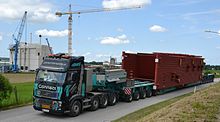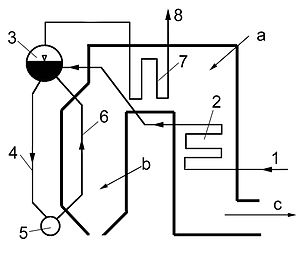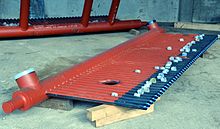Natural circulation boiler


A natural circulation boiler is a water-tube boiler in which the water-steam circulation is achieved due to the density difference between the water in the downpipes and the water-vapor phase in the heated evaporator part (thermosyphon effect).
Description of the circulation principle
The natural circulation boiler has an upper drum in which a water- vapor mixture is present. The saturated steam in the drum is separated from the water and runs on to the superheaters . Downpipes are used on the bottom of the drum, which either lead the water to a lower drum or, in today's designs, to the collectors below. The downpipes are unheated. According to the static column in the downpipes, calculated from the water level in the upper drum, the state of the water is slightly below the boiling line, so that the water in the downpipes does not contain any water vapor bubbles. The water is routed from the distribution devices below to the evaporator heating surfaces. These can be the pipe walls of the boiler or evaporator bulkheads. The radiation and convection of the flue gases heat the water up to saturated steam temperature. The density of the hotter water-steam mixture in the heated pipes is significantly lower than the density in the downpipes, so that a flow directed towards the top drum is initiated in the heated part.
The upper drum, mostly just called drum, has the following functions:
- Compensation of short-term fluctuations in steam generation,
- Achieving the longest possible sinking time if dining facilities fail,
- Separation of the vapor and separation of liquid droplets on splash plates and metal wire inserts,
- Fitting of the safety equipment on the boiler water side (drum safety valve , water level , pressure limiter , water gauge ).
When superheated steam is required, the saturated steam from the drum is fed to the superheaters .
history
The natural circulation boiler as an inclined tube evaporator or as an arrangement with top and bottom drum is the oldest type of water tube boiler, which was developed at the end of the 19th century. The boiler walls were bricked up until the 1960s. A major leap in development was the introduction of membrane walls with fin tubes . The heating surface and the boiler efficiency could be improved significantly. This type of boiler is also known as a steep tube boiler. If the boiler only of a train exists, the evaporator, superheater and economiser receives, then we speak of the tower boiler . This type of construction has the advantage that the thermal stresses can be better controlled with an elongated boiler body.
construction


Natural circulation steam generators consist of four essential components :
- Upper drum (3) - it serves as a water reservoir and in it the steam-water separation ("phase separation") takes place. It is above the combustion chamber (b) and the downpipes (4) and riser pipes (6) go from it. The drum is filled with feed water from the feed pump via the feed water line (1) . Most of the time, the water is passed through the economiser (feed water preheater) (2) in order to preheat the water and make better use of the heat contained in the flue gas.
- The water flows from the downpipes (4) to the manifold (5).
- The task of the distributor header (5) is to ensure that the water supplied is evenly distributed over the riser pipes (6). It is sometimes referred to as the "lower drum".
- The pipe walls (6) that delimit the combustion chamber (b) or are built into the combustion chamber as bulkheads are referred to as riser pipes. The firing in the combustion chamber heats these pipes and thus the water inside the pipes. The density of the water inside these pipes is lower than the density of the water in the downpipes due to the higher temperature and the steam content at the same pressure . Inside the riser there is a mixture of water and steam, because some of the water is evaporated by the heating. The riser pipes open into the drum at the upper end, thus completing the cycle.
Advantages and disadvantages
The advantage of the natural circulation principle is that, in contrast to forced circulation and once-through boilers, no circulation pump is required. At least one reserve unit must be available for a circulation pump in order to be able to dissipate the residual heat in the event of a pump failure.
If the volume of the upper drum on a natural circulation boiler is sufficiently dimensioned to provide enough water to dissipate the residual heat in the event of a fault shutdown, then the boiler is self-safe; d. That is, no emergency feed or emergency circulation devices are required. The relatively simple structure and ease of use of the system are reasons why the natural circulation principle is still preferred for medium-sized systems.
When designing the heating surfaces , it must be ensured that all connected evaporator tubes are adequately supplied with water in all operating states. For this reason, hydraulic balancing may be necessary by installing throttles. In general, larger pipe dimensions have to be used than with boilers that are operated in forced circulation. Therefore, certain restrictions in the construction of natural circulation boilers must be observed. The heated pipes from the collectors below must always be laid with an incline so as not to generate steam bubbles that would override the natural circulation.
The boiler tubes must be dimensioned in such a way that under full load not more than 30% of the water evaporates in one cycle. Otherwise the steam content in the pipes is so great that no continuous water film remains on the pipe walls. There is then the risk of overheating, since the heat transfer is significantly impaired by the inner vapor film; this is known as a boiling crisis .
Natural circulation boilers must be equipped with an upper drum. Since the natural circulation boiler can only work below the critical point due to its functional principle and a sufficient difference in density between water and steam is necessary, natural circulation boilers are only designed for operating pressures of up to approx. 200 bar. In addition, the difference in density between water and steam is not sufficient to achieve, on the one hand, a sufficient number of revolutions in the evaporator and, on the other hand, adequate separation of the water from the steam. Systems with a superheater outlet pressure of 190 bar have been in operation for many years. For large steam power plants (output> 150 t / h), forced flow and forced circulation boilers are preferred,
- as higher efficiencies are achieved at higher pressures,
- the boiler can be better regulated and
- fewer restrictions in the design have to be taken into account.
See also
literature
- Helmut Effenberger: Steam generation. Springer-Verlag, ISBN 3-540-64175-0
- Kugeler, Phlippen: Energy technology. 2nd edition, Springer-Verlag, ISBN 3-540-55871-3
- K. Stephan: Heat transfer when condensing and boiling. Springer publishing house
- K. Strauss: Power plant technology. 4th edition, Springer-Verlag, ISBN 3-540-64750-3